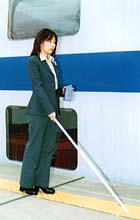PLATFORM ONE IS ON YOUR LEFT:
Voice Guidance System Developed for Visually Impaired
May 15, 2000
 |
|
| The voice guidance system makes walking along station platforms easier and safer for the visually impaired. (Railway Technical Research Institute) |
|
The Railway Technical Research Institute has recently developed a system that guides visually impaired people around train stations by giving them spoken directions. It can help them find their way, for example, to the platform or the ticket gate. Many experts believe that if the so-called barrier-free transport bill that is currently before the National Diet is enacted, it will act as a spur to the further development of such "disabled-friendly" devices and facilities.
Spoken Directions
The voice guidance system developed by RTRI works like this: Positional information for ticket gates, platforms, kiosks, and other facilities is stored inside integrated-circuit chips embedded in braille blocks. These chips transmit the information via the user's walking cane to a pocket-sized terminal weighing 240 grams (8.5 ounces), which converts that information into directions that it "speaks" to the user in a synthesized voice.
If the user says to the terminal, "Platform one," the terminal picks up information on the user's current position from the braille blocks via the cane, calculates the best route, and proceeds to give vocal directions, such as "Turn left" or "Go forward 20 meters."
Many visually impaired people say that the danger of falling from the platform makes them very nervous. It is hoped that a system that helps the visually impaired get around platforms with information assuring them that they are walking in a safe area or steering them away from areas of danger will help to allay some of those fears.
Make It Lighter
When RTRI asked disabled people to try out the system, some said they wished it was lighter and that the vocal input system worked more smoothly. The institute is looking to use these suggestions to improve the system and to have it ready for actual use soon.
Many of Japan's railway stations were built several decades ago, and a large number of them still have long staircases and other original features that make them difficult for elderly and disabled people to navigate. As part of plans to improve this situation, the government submitted a "barrier-free" bill to the Diet in February 2000. Its central plank is to oblige transport institutions, including railway companies, to conform to minimum standards of access for disabled people whenever they build new facilities or undertake major renovations of old ones. If the bill is enacted, it will certainly lend wings to current efforts to make public transport more accessible for disabled people.
 Copyright (c) 2000 Japan Information Network. Edited by Japan Echo Inc. based on domestic Japanese news sources. Articles presented here are offered for reference purposes and do not necessarily represent the policy or views of the Japanese Government. Copyright (c) 2000 Japan Information Network. Edited by Japan Echo Inc. based on domestic Japanese news sources. Articles presented here are offered for reference purposes and do not necessarily represent the policy or views of the Japanese Government.
| 



















